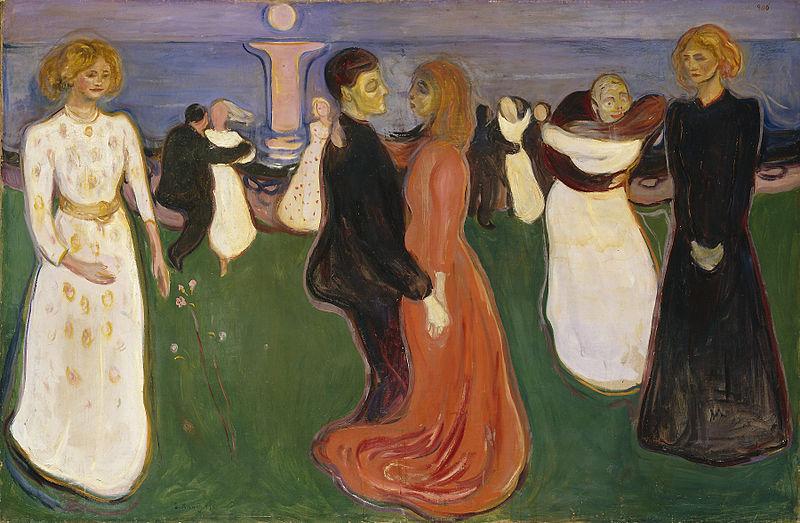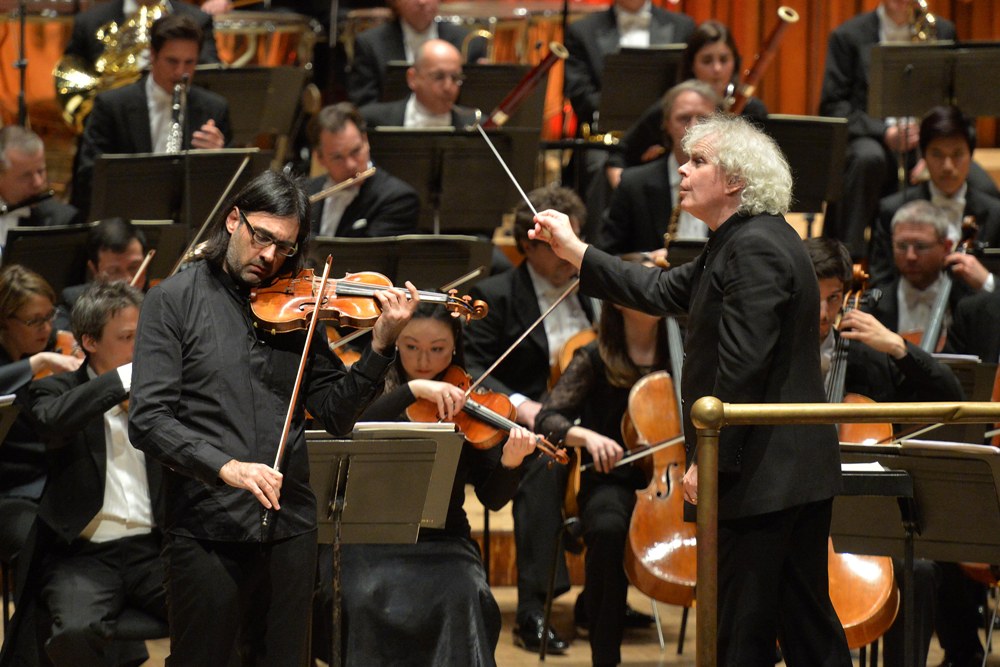Sibelius Cycle 2, Kavakos, Berliner Philharmoniker, Rattle, Barbican | reviews, news & interviews
Sibelius Cycle 2, Kavakos, Berliner Philharmoniker, Rattle, Barbican
Sibelius Cycle 2, Kavakos, Berliner Philharmoniker, Rattle, Barbican
Well-earthed journeys across middle-period symphonic landscapes don't always move freely

Bass lines were Edward Seckerson’s starting point yesterday in welcoming the Berlin Philharmonic Sibelius cycle to London, and none strikes more terror from the depths than the subterranean growl that launches the most selectively-scored symphony of the 20th Century, the Fourth.
Yet the beginning of the concert reminded us that cellos and a slightly smaller complement of basses also launch the Third Symphony at the opposite end of the dynamic scale, and in very different mode. Here they weren’t nearly light enough to herald a true sense of cheerful adventure, and Sibelius’s epic journey took on nothing like the spring and sense of direction it needed.
Call it the contrast between the power of the earth, which Rattle’s Berliners can always manage, and the energy of the human, which on this evidence isn’t their strong point. Rattle has made one of the best observations about John Adams's music, that it "always seemed to be moving forward in space", but he doesn't seem to be able to apply that to the supreme mover Sibelius. The Third's finale, which evolves with what should be imperceptible dynamism into something strong and noble, had too many bumps along the way and didn’t hit the peroration convincingly enough. A well-oiled machine and traffic lights aren’t necessary for Sibelius’s primal evolutions. Better were the circling motions of the fascinating, more-than-intermezzo middle movement, beautifully shaded with the peerless Berlin woodwind shining for the first of many occasions during the evening. But the hypnotic effect didn’t go quite as deep as in Sakari Oramo’s revelatory debut performance with the BBC Symphony Orchestra.
It was the same story with the Violin Concerto: outer movements problematic, core lyricism perfect. How Leonidas Kavakos (pictured above with Rattle and the Orchestra by Mark Allan for the Barbican) spun that central legato line, hooking us from first to last in the most conventional movement of the evening. He started unatmospherically, though, and never caught the sense of fantasy with which Lisa Batiashvili so bewitched at the Proms (again with Oramo). The last movement’s “dance with polar bears”, as the great musicologist Donald Tovey once put it, was dangerous in the wrong way, and a lovely bit of Bach by way of encore didn’t seem pertinent. It was good that the other players got to listen, but couldn’t they have prepared Sibelius’s delightful Humoresque No. 5 with their soloist? It hardly ever gets an airing in standard programming.
Once we struck the depths of the Fourth, earlier reservations were blown away. This time it’s my fault, not the orchestra’s, if tone-colours were so seductive that instead of thinking “what a mind-bending work” – which I know already – I couldn’t help registering instead at every turn “what astonishing artists”. It could hardly be otherwise with cellist Bruno Delepelaire – the noblest Don Quixote I’ve ever heard live in a Berlin performance of Strauss’s greatest symphonic poem – and flautist Emmanuel Pahud, though from both I wanted a bit more loneliness to temper the beauty of sound. Many of the best in this army of generals were out in force last night – including top oboist Albrecht Mayer; Andreas Ottensamer, the only clarinettist to win a recording contract of late; and viola player Amihai Grosz, formerly of the Jerusalem Quartet – and if it’s a good-looking orchestra too, well, that’s an incidental pleasure.
Rattle’s negotiation of each extraordinary idea and its mostly spare clothing couldn’t be faulted, but in my distraction at the sheer opulence of sound, perhaps I lost the line that builds every so slowly towards the tragic climax of the great Largo and the deeper sense of desolation in the symphony’s dying fall. Still, no doubt about it, this is a masterpiece that could have been written yesterday, and no-one makes you realize that quite like this super-orchestra.
rating
Share this article
The future of Arts Journalism
You can stop theartsdesk.com closing!
We urgently need financing to survive. Our fundraising drive has thus far raised £49,000 but we need to reach £100,000 or we will be forced to close. Please contribute here: https://gofund.me/c3f6033d
And if you can forward this information to anyone who might assist, we’d be grateful.

Subscribe to theartsdesk.com
Thank you for continuing to read our work on theartsdesk.com. For unlimited access to every article in its entirety, including our archive of more than 15,000 pieces, we're asking for £5 per month or £40 per year. We feel it's a very good deal, and hope you do too.
To take a subscription now simply click here.
And if you're looking for that extra gift for a friend or family member, why not treat them to a theartsdesk.com gift subscription?
more Classical music
 Hallé John Adams festival, Bridgewater Hall / RNCM, Manchester review - standing ovations for today's music
From 1980 to 2025 with the West Coast’s pied piper and his eager following
Hallé John Adams festival, Bridgewater Hall / RNCM, Manchester review - standing ovations for today's music
From 1980 to 2025 with the West Coast’s pied piper and his eager following
 Kaploukhii, Greenwich Chamber Orchestra, Cutts, St James's Piccadilly review - promising young pianist
A robust and assertive Beethoven concerto suggests a player to follow
Kaploukhii, Greenwich Chamber Orchestra, Cutts, St James's Piccadilly review - promising young pianist
A robust and assertive Beethoven concerto suggests a player to follow
 Robin Holloway: Music's Odyssey review - lessons in composition
Broad and idiosyncratic survey of classical music is insightful but slightly indigestible
Robin Holloway: Music's Odyssey review - lessons in composition
Broad and idiosyncratic survey of classical music is insightful but slightly indigestible
 Classical CDs: Wolf-pelts, clowns and social realism
British ballet scores, 19th century cello works and contemporary piano etudes
Classical CDs: Wolf-pelts, clowns and social realism
British ballet scores, 19th century cello works and contemporary piano etudes
 Bizet in 150th anniversary year: rich and rare French offerings from Palazzetto Bru Zane
Specialists in French romantic music unveil a treasure trove both live and on disc
Bizet in 150th anniversary year: rich and rare French offerings from Palazzetto Bru Zane
Specialists in French romantic music unveil a treasure trove both live and on disc
 Scottish Chamber Orchestra, Ibragimova, Queen’s Hall, Edinburgh review - rarities, novelties and drumrolls
A pity the SCO didn't pick a better showcase for a shining guest artist
Scottish Chamber Orchestra, Ibragimova, Queen’s Hall, Edinburgh review - rarities, novelties and drumrolls
A pity the SCO didn't pick a better showcase for a shining guest artist
 Kilsby, Parkes, Sinfonia of London, Wilson, Barbican review - string things zing and sing in expert hands
British masterpieces for strings plus other-worldly tenor and horn - and a muscular rarity
Kilsby, Parkes, Sinfonia of London, Wilson, Barbican review - string things zing and sing in expert hands
British masterpieces for strings plus other-worldly tenor and horn - and a muscular rarity
 From Historical to Hip-Hop, Classically Black Music Festival, Kings Place review - a cluster of impressive stars for the future
From quasi-Mozartian elegance to the gritty humour of a kitchen inspection
From Historical to Hip-Hop, Classically Black Music Festival, Kings Place review - a cluster of impressive stars for the future
From quasi-Mozartian elegance to the gritty humour of a kitchen inspection
 Shibe, LSO, Adès, Barbican review - gaudy and glorious new music alongside serene Sibelius
Adès’s passion makes persuasive case for the music he loves, both new and old
Shibe, LSO, Adès, Barbican review - gaudy and glorious new music alongside serene Sibelius
Adès’s passion makes persuasive case for the music he loves, both new and old
 Anja Mittermüller, Richard Fu, Wigmore Hall review - a glorious hall debut
The Austrian mezzo shines - at the age of 22
Anja Mittermüller, Richard Fu, Wigmore Hall review - a glorious hall debut
The Austrian mezzo shines - at the age of 22
 First Person: clarinettist Oliver Pashley on the new horizons of The Hermes Experiment's latest album
Compositions by members of this unusual quartet feature for the first time
First Person: clarinettist Oliver Pashley on the new horizons of The Hermes Experiment's latest album
Compositions by members of this unusual quartet feature for the first time


Add comment